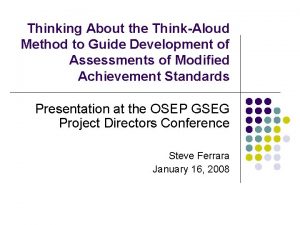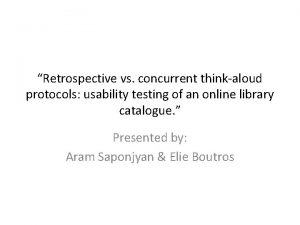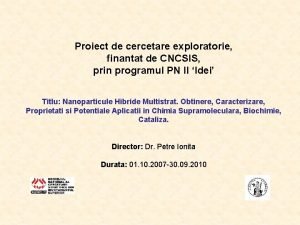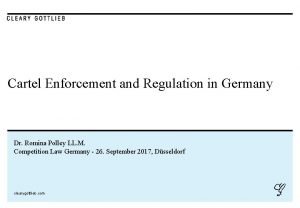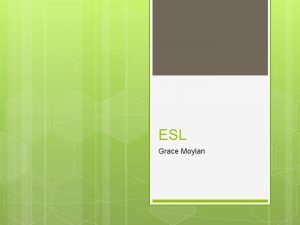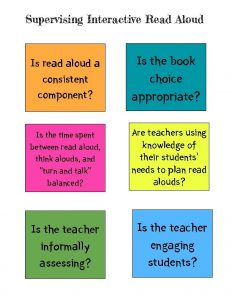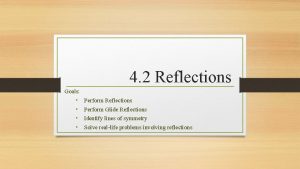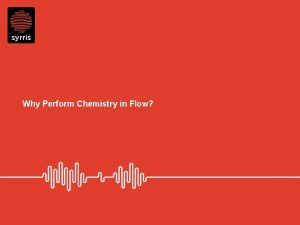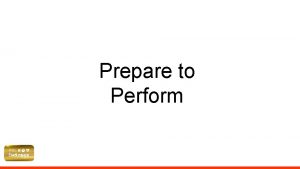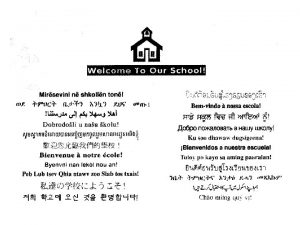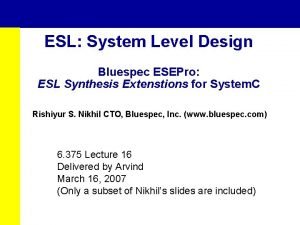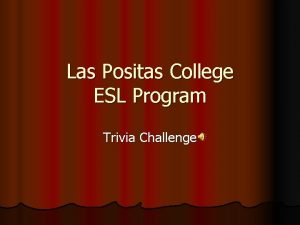THINK ALOUD INTRODUCE PERFORM ASSESS ROMINA PLOZZA ESL















- Slides: 15

THINK ALOUD INTRODUCE, PERFORM, ASSESS ROMINA PLOZZA ESL INSTRUCTOR

INTRODUCTIONS Romina Plozza ESL Instructor Shoreline Community College rplozza@shoreline. edu v. What’s your name? v. Where and what do you teach? 2

WHAT IS A THINK ALOUD? Instead of telling students what a Think Aloud is, model it for them. Allow them to “eavesdrop on your thinking”. Model how skilled readers construct meaning from a text. 1) Find “Wrong Channel” in your package (p. 1) 2) Listen to me model a Think Aloud 3) Take notes. What do you hear me say/do? 3

SHARE OUT What did you hear me say/do? What are some strategies I used to make sense of the text? 4

IT’S YOUR TURN! 1) Pick one of the texts in your packet. a) English as a Second Language (p. 2) b) Greek Literature (p. 3) c) Science/Medicine (p. 4) d) History (p. 5) 2) Find a partner: Think Aloud as if you were modeling the strategy for your students. 3) You may use the Think Aloud bookmark to help you. 4) You have 3 minutes each. 5

SMALL GROUPS DISCUSSION How did it go? What were some challenges? Did you use all of the strategies on the bookmark, or did you focus on just a few? Why? 6

STUDENTS’ REACTIONS Laith Maureen 7

FROM MODELING TO PERFORMING 1. Model Think Aloud several times and with different texts/strategies. 2. Discuss why it is important to use those strategies – purpose/goal 3. Whether they read something for homework or in class, ask Think Aloud questions! Get them used to thinking this way. When you feel they are ready to give it a try, have them do it themselves! 8

9 TIME TO REFLECT What are some challenges you anticipate when using Think Aloud with your students? What do you think the rewards might be in terms of achievement/motivation?

REWARDS & CHALLENGES Rewards Challenges Survey with 16 ESLAB 050 students New concept: I enjoy reading more (16) “What is this? ” “I never heard of this. ” “I have never been asked to do this. ” I started to read more outside of class (9) I feel more confident when I take tests (13) My writing has improved (16) My grammar and vocabulary have improved (16) I can read and understand more difficult texts (16) Effectiveness: “Why do I need to slow down my reading? ” “How is this helping? ” I would like to use the same strategies in other classes (16) Method: “I think my English is better because in this class I feel safe to speak when I have problems with language. Think Aloud help me understand books, my classmate, and me. ” (ESL Level 5 student) “How many comments do you need? ” “How many times do I have to stop in a sentence? ” “How long should my reaction be? ” 10

ON OVERCOMING CHALLENGES New concept: Safe and collaborative class environment: Introduce other RA activities (e. g. , Reading History, Roadblocks, and Reading Strategies) If you believe in it, they believe in it. Effectiveness: It’s a process. Eventually connections will happen naturally and more quickly. Focus on the purpose/goal of the activity (missteps) Method: Specific Instructions Strong students work with less proficient students Controlled practice p. 14 11

PAIRED THINK ALOUD A reader & a conscience On page 6 in your packet, you can find a document with example questions. In steps: 1. Conscience uses the questions provided 2. Conscience uses bookmark 3. Paired Think Aloud happens naturally/turns into a Think Aloud 12

PAIRED/GROUP THINK ALOUD Paired Think Aloud Group Think Aloud A reader and a conscience Taking turns reader/conscience p. 7 - Journal 13

READING TESTS When we ask our students to perform a Think Aloud, we are teaching them how to do the following: Summarize (find keywords and main ideas) Apply strategies to understand words in context Apply world/text/language/discipline knowledge to make sense of the text Predict/Think critically Ask Questions React to the text If we are teaching them to “Think Aloud”, shouldn’t we assess those skills? (p. 8 -9) 14

ASSESSMENT TOOLS FEEDBACK Activities/Tests (pp. 7 -13) Ø Paired Think Aloud Ø Reading Tests Ø Think Aloud (oral) Ø Think Aloud (written) Ø Think Aloud (journal/analysis) You will be assigned an assignment/rubric. Analyze it by answering the following questions: 1. What are the strengths/weaknesses of this assignment/rubric? 2. Would you use it with your students? Why/Why not? 3. Suggestions for improvement? Find someone with a different color card – share Leave your card in the box on the desk = Feedback for RA folks 15

